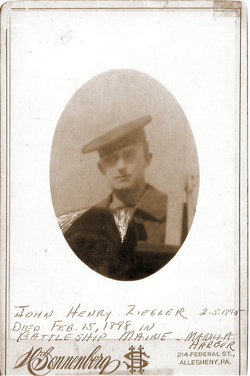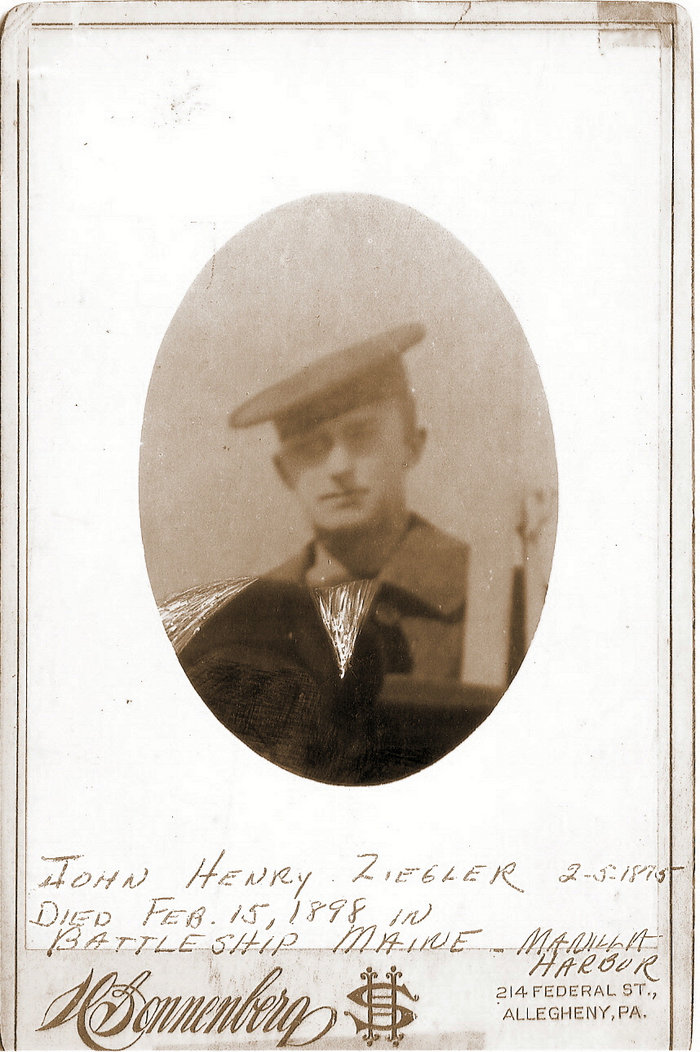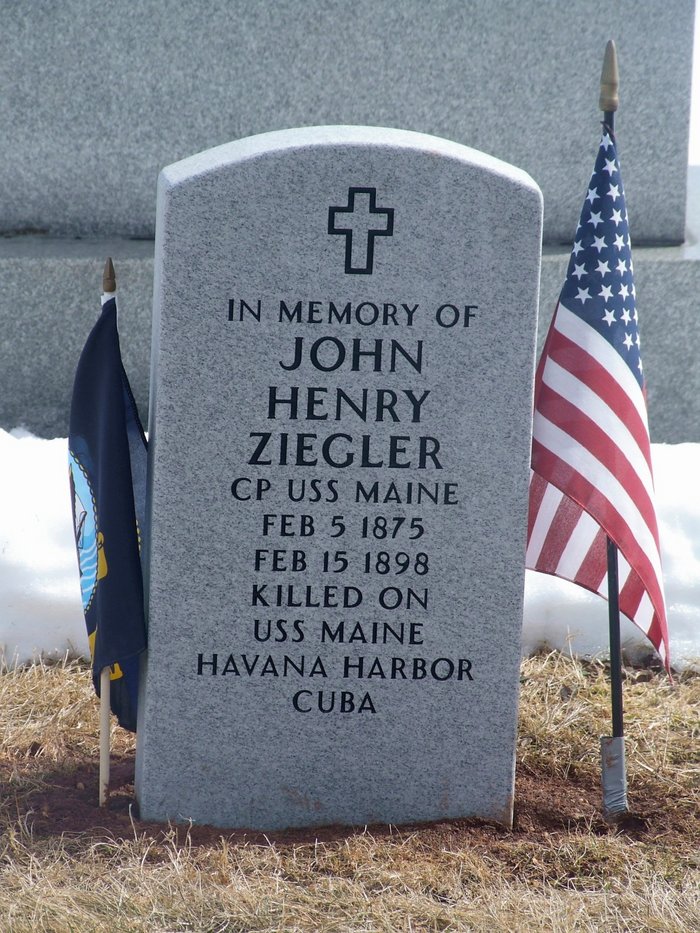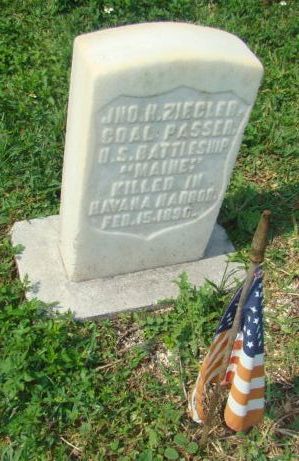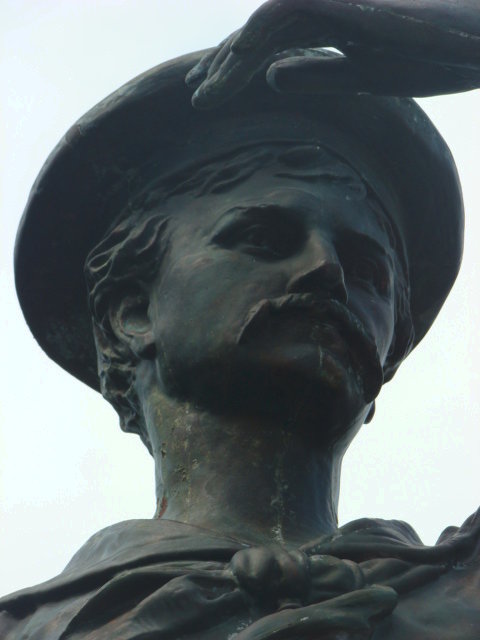___________________________________________
John Henry Ziegler was born to Jacob and Louise Ziegler in February of 1875. He was the second oldest of nine children. The family lived in Long Island, New York until the 1880's, when they settled in New Brunswick, New Jersey. Around 1896, John began his service within the United States Navy and was made a member of the newly commissioned Cruiser USS Maine's crew. In January of 1898, the Maine was sent on a peaceful voyage to Havana Harbor, Cuba in order to keep watch over American citizens and interests on the island.
On February 15, at 9:40 p.m. the ship mysteriously exploded, immediately killing 258 sailors. Eight others would later die of their wounds, including Frederick Jernee and William Robinson- two other New Brunswick natives. Captain Charles D. Sigsbee's report following the disaster listed John Ziegler as "missing". In December 1899, as the remainder of the bodies buried in Havana were being prepared to be shipped to Arlington, Virginia for internment, the Navy sent notifications to the families of the dead giving them the oppurtunity to request for their loved one's body to be returned to them- should their coffin be indentified. Louise Ziegler requested for her son's body to be sent home to New Jersey so it could be buried within the family's cemetery plot. The Navy never complied.
In September of 2009, John Ziegler's Great-Great-Great Nephew, Billy Griffith, began a search to find out what really happened to his relative's remains. After extensive research and reviewing old New Brunswick Daily Times articles from the 19th century, Griffith was convinced that the Navy had mad a mistake. In one article from 1899, there was a report that an officer on leave had informed New Brunswick natives that he has assisted with the burials in Cuba and had seen the coffin of Ziegler and Robinson. However, this could not explain the Navy's assumption that both sailors were "missing".
Believing that it was possible that Ziegler's body was accidentally interred in Arlington, the Griffith's called the cemetery, but it was to no avail. There was no labeled headstone with John's name. It was probable that he was burried as one of the 2/3 of the crew that simply are labeled as "unknown".
The search did not stop there. Billy was determined to find all that he could know about the fallen sailor. Upon further research, the family stumbled upon a cemetery in Key West, Florida that showed record of having 27 Maine sailors interred within the grounds. After getting in touch with the cemetery's sexton, the family was informed that Ziegler's remains were indeed interred inside the Maine plot. The search was over. An 111-year-old family mystery had been solved.
This wasn't the end however. Determined to have Ziegler remembered, the family petitioned to have a memorial headstone placed within the Ziegler family's North Brunswick plot. After several attempts to recieve a stone, the Veterans Administration finally complied, and on February 20, 2010, a memorial service was held in honor of John Ziegler by the Manville VFW. Over 60 people attended the ceremony.
Positioned next to Louise Ziegler's grave- in a space that had remained empty for nearly 112 years- is her son's memorial headstone. After over a century, a mother's wishes for her son had finally been fulfilled.
__________________________________________
Memorials
___________________________________________
Memorial at Arlington National Cemetery In February of 1898, the recovered bodies of sailors who died on the American Battleship Maine were interred in the Colon Cemetery, Havana. Some injured sailors were sent to hospitals in Havana and Key West. Those who died in hospitals were buried in Key West. In December of 1899 the bodies in Havana were disinterred and brought back to the United States for burial at Arlington National Cemetery where there is a memorial to those who died and which includes the ship's main mast. Some bodies were never recovered and the crewmen buried in Key West remain there under a statue of a U.S. sailor holding an oar. There is also a memorial, consisting of the shield and scrollwork from the bow of the ship, in Bangor, Maine. Shells from the main battery were placed along with small plaques as memorials at the Soldier's Home in Marion, Indiana (now a VA Hospital and national cemetery) and at the St. Joseph County Courthouse lawn in South Bend, Indiana. The base of the Maine's conning tower is currently on display at Westbrook Veterans' Memorial Park in Canton, Ohio, hometown of President McKinley. A shell from the main battery is located just inside of the Pine St. entrance of city hall in Lewiston, Maine. The explosion-bent fore mast of the Maine is located at the United States Naval Academy at Annapolis, Maryland. There is a monument for the Maine and a portion of a bronze engine room ventilator shaft from the Maine in Pompton Lakes, New Jersey. There is a traditional in-joke among midshipmen at the Academy that the Maine, with its main mast in Eastern Virginia and its fore mast in Central Maryland, is the longest ship in the Navy.
___________________________________________
On August 5, 1910, Congress authorized the raising of the Maine to remove it as a navigation hazard in Havana Harbor. On February 2, 1912, she was refloated under supervision of the Army Corps of Engineers and towed out to sea where she was sunk in deep water in the Gulf of Mexico on March 16, 1912, with appropriate military honors and ceremonies.
___________________________________________
John Henry Ziegler was born to Jacob and Louise Ziegler in February of 1875. He was the second oldest of nine children. The family lived in Long Island, New York until the 1880's, when they settled in New Brunswick, New Jersey. Around 1896, John began his service within the United States Navy and was made a member of the newly commissioned Cruiser USS Maine's crew. In January of 1898, the Maine was sent on a peaceful voyage to Havana Harbor, Cuba in order to keep watch over American citizens and interests on the island.
On February 15, at 9:40 p.m. the ship mysteriously exploded, immediately killing 258 sailors. Eight others would later die of their wounds, including Frederick Jernee and William Robinson- two other New Brunswick natives. Captain Charles D. Sigsbee's report following the disaster listed John Ziegler as "missing". In December 1899, as the remainder of the bodies buried in Havana were being prepared to be shipped to Arlington, Virginia for internment, the Navy sent notifications to the families of the dead giving them the oppurtunity to request for their loved one's body to be returned to them- should their coffin be indentified. Louise Ziegler requested for her son's body to be sent home to New Jersey so it could be buried within the family's cemetery plot. The Navy never complied.
In September of 2009, John Ziegler's Great-Great-Great Nephew, Billy Griffith, began a search to find out what really happened to his relative's remains. After extensive research and reviewing old New Brunswick Daily Times articles from the 19th century, Griffith was convinced that the Navy had mad a mistake. In one article from 1899, there was a report that an officer on leave had informed New Brunswick natives that he has assisted with the burials in Cuba and had seen the coffin of Ziegler and Robinson. However, this could not explain the Navy's assumption that both sailors were "missing".
Believing that it was possible that Ziegler's body was accidentally interred in Arlington, the Griffith's called the cemetery, but it was to no avail. There was no labeled headstone with John's name. It was probable that he was burried as one of the 2/3 of the crew that simply are labeled as "unknown".
The search did not stop there. Billy was determined to find all that he could know about the fallen sailor. Upon further research, the family stumbled upon a cemetery in Key West, Florida that showed record of having 27 Maine sailors interred within the grounds. After getting in touch with the cemetery's sexton, the family was informed that Ziegler's remains were indeed interred inside the Maine plot. The search was over. An 111-year-old family mystery had been solved.
This wasn't the end however. Determined to have Ziegler remembered, the family petitioned to have a memorial headstone placed within the Ziegler family's North Brunswick plot. After several attempts to recieve a stone, the Veterans Administration finally complied, and on February 20, 2010, a memorial service was held in honor of John Ziegler by the Manville VFW. Over 60 people attended the ceremony.
Positioned next to Louise Ziegler's grave- in a space that had remained empty for nearly 112 years- is her son's memorial headstone. After over a century, a mother's wishes for her son had finally been fulfilled.
__________________________________________
Memorials
___________________________________________
Memorial at Arlington National Cemetery In February of 1898, the recovered bodies of sailors who died on the American Battleship Maine were interred in the Colon Cemetery, Havana. Some injured sailors were sent to hospitals in Havana and Key West. Those who died in hospitals were buried in Key West. In December of 1899 the bodies in Havana were disinterred and brought back to the United States for burial at Arlington National Cemetery where there is a memorial to those who died and which includes the ship's main mast. Some bodies were never recovered and the crewmen buried in Key West remain there under a statue of a U.S. sailor holding an oar. There is also a memorial, consisting of the shield and scrollwork from the bow of the ship, in Bangor, Maine. Shells from the main battery were placed along with small plaques as memorials at the Soldier's Home in Marion, Indiana (now a VA Hospital and national cemetery) and at the St. Joseph County Courthouse lawn in South Bend, Indiana. The base of the Maine's conning tower is currently on display at Westbrook Veterans' Memorial Park in Canton, Ohio, hometown of President McKinley. A shell from the main battery is located just inside of the Pine St. entrance of city hall in Lewiston, Maine. The explosion-bent fore mast of the Maine is located at the United States Naval Academy at Annapolis, Maryland. There is a monument for the Maine and a portion of a bronze engine room ventilator shaft from the Maine in Pompton Lakes, New Jersey. There is a traditional in-joke among midshipmen at the Academy that the Maine, with its main mast in Eastern Virginia and its fore mast in Central Maryland, is the longest ship in the Navy.
___________________________________________
On August 5, 1910, Congress authorized the raising of the Maine to remove it as a navigation hazard in Havana Harbor. On February 2, 1912, she was refloated under supervision of the Army Corps of Engineers and towed out to sea where she was sunk in deep water in the Gulf of Mexico on March 16, 1912, with appropriate military honors and ceremonies.
Family Members
Advertisement
Explore more
Sponsored by Ancestry
Advertisement
